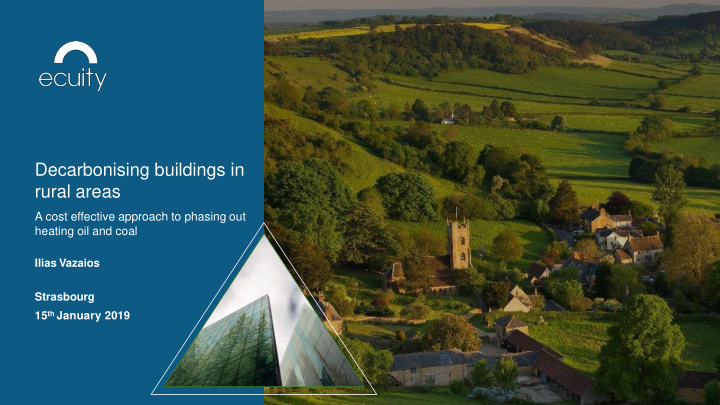



Decarbonising buildings in rural areas A cost effective approach to phasing out heating oil and coal Ilias Vazaios Strasbourg 15 th January 2019
1 Reducing building carbon emissions • Buildings currently represent the highest share of final energy consumption in the EU. • New buildings can be designed and constructed with high-performance thermal insulation. However, buildings built today will only represent 10-25% of the buildings stock in 2050. • Currently, about 35% of the EU's buildings are over 50 years old and almost 75% were built before energy performance standards existed. • In Europe's residential building stock, 71% of all energy is used for space heating alone. • The energy consumed by heaters could be progressively significantly reduced, thanks to replacement of the most inefficient segments with more efficient alternatives, which range from condensing boilers to heat pumps in combination with better controls and smarter packages of heaters (e.g. combinations of several heating systems). • In the future, hydrogen-fuelled heating could play a bigger role, especially in off-grid areas, where there are a limited number of flexibility sources that can ensure the balance in the heating system.
2 Rural heat needs a bespoke approach • There are 40.7 million households located in rural off-gridareas across Europe. Over 50% of European citizens. • A significant proportion of these properties have no connection to the gas grid and use heating systems run on high-carbon fossil fuels: heating oil and coal. Such high emission heating will need to be replaced if Europe is to meet it’s climate change targetscost-effectively. • These off-grid homes are typically less energy-efficient , andmore difficult to treat than many urban properties. • People living in rural areas are more likely to be living in poverty or suffering from social exclusion (24.4%). Given that governments are unlikely to cover all of the financial cost of this energy transition, investment and operating costs are particularly important to consider for rural areas.
3 Prevalence of heating oil and coal
4 Oil and coal phase out is needed in rural homes Paris Treaty Doing-nothing scenario EU 2050 target 13% CO 2 emissionreduction Keep temperature rise 80% CO 2 emission well below 2 ° C reduction France Denmark UK Belgium Phase out Phase out new Phase out Phase out heating oil heating oil heating oil by heating oil and foreseen for 2027 boilers by 2035 2030 coal by 2030
5 Rapid switching scenario: CO 2 emissions • Over the period 2016-2050, emissions fall from 104 MtCO 2 to 17 MtCO 2 – an 88% reduction. • This pathway can support the EU’s decarbonisation objectives. However key challenges remain with many of the low carbon technologies and fuels (see table below), including: Consumer cost barriers – particularly with the 1. upfront cost of heat pumps and biomass boilers. Security of supply – further development of supply 2. chain needed for low-carbon fuels such as biopropane. Governments can support this process. 3. Status quo bias and consumer familiarity with existing heating systems could mean that switching many households over to new technologies is challenging.
6 Optimised rapid switching scenario: CO 2 emissions • Optimising the deployment of alternatives between the six countries under the mixed technology pathway reduces the cost of this off grid heating transition, from a cumulative €30bn over the period, to €11bn in the mixed technology pathway. • In terms of carbon abatement costs, this reduces the cost of abating 1 tonne of CO 2 , from €21/tCO 2 (100% heat pump pathway), to €8/tCO 2 .
Interplay with air quality targets • Modelling for the Scenario's for decarbonising homes in Europe’s rural areas report carried out a cost minimisation to estimate the optimal displacement of heating oil and coal with lower carbon technologies up to 2050: • 44% electric heat pumps • 44% LPG/bioLPG • 12% biomass • The graphic in the top left shows the rapid switching scenario developed. The displacement of heating oil and coal delivers both CO 2 reductions and air pollutant saving: • NOx falls from 127 Gt to 44 Gt, a 65% reduction • PM 2.5 reduces from 81 GT to 15 Gt, 82% reduction • PM 10 falls from 90 Gt to 14 Gt, an 85% reduction • SO x falls from 425 Gt to 46 Gt, an 89%reduction • This is whilst CO 2 emissions fall by 88% against a 1990 baseline.
9 Main findings 1. Rural homes are typically off the gas grid and tend to be diverse in terms of building typology, consumer characteristics and heating fuels. A more focused approach to assessing needs and developing policy is necessary. 2. Our analysis showed that Europe could achieve a 88% reduction in off-grid residential heating emissions by banning the sale of new heating oil and coal boilers in the early 2020s, and supporting lower carbon alternatives – heat pumps, biomass and (bio)LPG. 3. With limited finance to support the transition away from heating oil and coal, it is more cost-effective to support a mixed technology approach to take account of the diverse characteristics of the off-grid building stock. For a fixed €1bn investment, the mixed technology scenario will save over 2.7 times more CO 2 emissions than the more expensive 100% heat pump scenario. 4. Air pollution from heating is an issue including in rural areas. Decarbonisation of heat will also deliver significant air quality benefits that need to be considered in tandem. 5. Scenario work, data analysis and policy innovation need to consider the specificities of rural off the gas grid heat and consider it separately, prioritising it to achieve policy objectives.
Recommend
More recommend